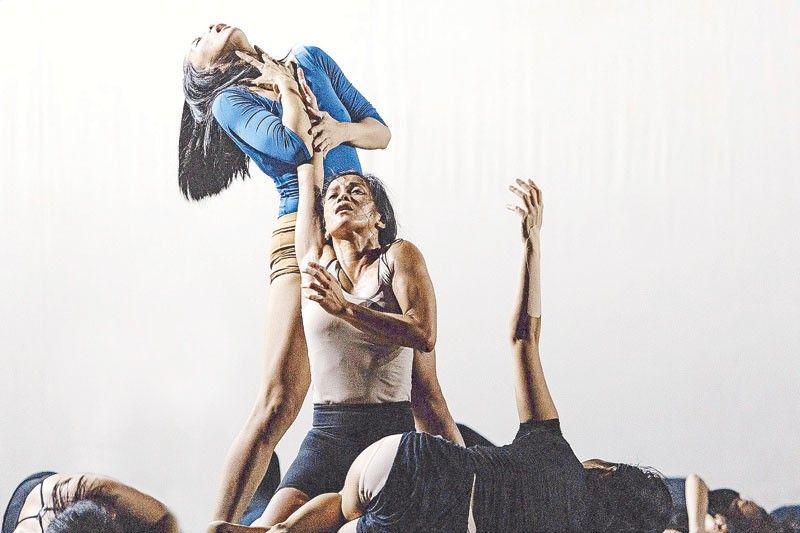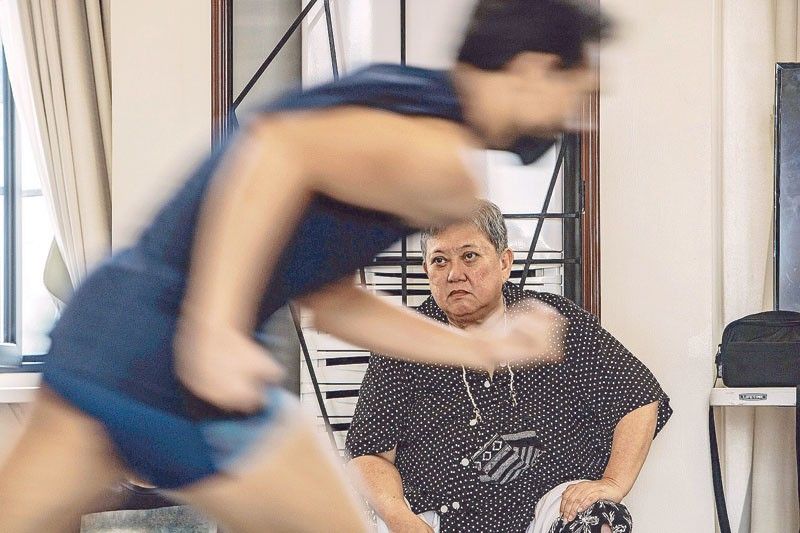Performing the Sacred in Agnes Locsin's 'Encantada'

MANILA, Philippines — Since the world premiere of Agnes Locsin’s Encantada in February 1992 (with the title role played then by Cecille Sicangco), and since its restaging in August 2011, this marvel of a Philippine neo-ethnic magnum opus returns onstage this April. With over more than three decades and three generations of dancers and audiences, it has indeed come of age. Hopefully, this unpublished review of its restaged production in August 2011 at the Cultural Center of the Philippines is now timely enough to be shared.
As the curtain rises, the Encantada (performed by Georgette Sanchez at the 2011 gala show) is regal on top of a bamboo-framed mountain. Veiled by a rainbow mist designed by National Artist Salvador Bernal with lighting by John Neil Illao Batalla, the Encantada delicately opens her arms as though drawing vines apart in the woods; then with wrists rotating gently, weaves spirals towards heaven and down to her dominion. She then begins to sway and descend the slopes to Bayang Barrios’ husky chants and tungatong (hollow bamboo tube) beats by Joey Ayala and his band. The libretto is by Al Santos.
The kababaihan (women) become animated by her presence as she touches and invites the babaylan (the shamaness, played by Katherine Trofeo) to rise and join her traipsing and animate the other women. The kababaihan assume modern ballet’s postures, swaying scoops and spirals heavenward and earthward, in a ritualistic dance of worship. As the Encantada spins among the kababaihan, their trunks jerk, legs shake, and arms become loose and free.
The Encantada does not appear purely ethereal. As Ina ng Kalikasan (Mother of Nature), she is solid yet light. She is not the classical sugar plum fairy who does her mincing steps en pointe; rather, her feet are in full contact with the ground, flexed; her legs in angular configurations. Her leaps, jumps, and turns are delicately tensile and minimal. The mountain goddess manifests herself among humans with earthbound impassioned grace.
This vibrant awakening by the Encantada ends with her ascent back to the mountain. The women bow in deference to the goddess who directs them in praising the supreme being over all of nature.
A gossamer scrim of a fortress and church façade descend from the stage rafter and the mountain scape fades to give way to the poblacion plaza. A susurrus of prayers reach a crescendo against the staging of the friars’ cruelty over the townsfolk who tortuously crawl and are dragged around by the guardias civiles. The act is reminiscent of fallen gladiators beaten and executed by the ancient Romans as in Juan Luna’s “Spoliarium.” The Extranjero (Stranger) steals the friars’ santo — a Marian image; but the brusque guardias civiles, their heads jerking in isolation sideways, masked in Moriones style but moving akin to traditional Indonesian theater, catch upon him. He gets wounded in the chase and ends up in the mountain dwelling. The Encantada and kababaihan fend off the intruders from their sacred ground.
As they take the fugitive into their care for a ritual of healing, the atmosphere turns to calm and quiet. The women lie facedown, side by side, on the ground — with the unconscious man lying on his back over the women and perpendicular to their row of bodies. The women each roll over, successively transporting the men from one woman’s body to the next — as if the man is gently floating over a friendly wave. The women have become water elements.
One woman cradles his head onto her lap. The Encantada guides the babaylan in her healing of the wounded man. The women stretch out their hands with palms over the man’s body — a “praying over.” The Encantada waves her arms and weaves unseen threads of energy to summon a healing miracle.

As a revival performance, it is astounding that this movement sequence still mesmerizes. The authentic esoteric is transmuted into dance aesthetic; yet its mystique does not miss the enthralling moment. Such is the mystery of numinous ritual — the sacred, done with reverent care, radiates efficacy even in art. Although she is bold, daring and at times thought to be irreverent, as an innovative artist, Locsin keeps faithful to the liminal core of her cultural roots. After an extended passage of time since its premiere, this ritualistic dance design has been restaged and is, thus, memorialized.
Locsin appropriates gestures from the Mindanao pangalay with circling shoulders, undulating arms, wavy elbows, hand scoops and palm and fingers extremely flexed as well as body stances and footwork of the Ifugao, Bukidnon and the Bagobo. These indigenous Philippine groups themselves have busy footwork, and they stamp repeatedly but with knees bent and torsos crouched, they bounce lightly and gently like birds. Not even the warrior dance of the Kalinga would generate literal earthshaking and thunderous footwork. But Locsin, a modernist, re-enforces the indigenous stomp with tough terrine thud and conjures a ritualistic celebration for the Santo which the Encantada regards as the mountain’s anito (spirit deity). The image, undressed, is then devoid of its Catholic icon vestments. The anito is perched on a post and is worshipped by the kababaihan and the helpless Extranjero. In almost frenetic mirth along with the rich timbre of gongs, the kababaihan and the extranjero celebrate victory over the tyranny of the friars. Ayala’s ambiant gong music sustains the revelry à la Aklan’s Ati-atihan and Cebu’s Sinulog to the climactic distinctive tableau — the Encantada a monumental grace at the mountain peak and the kababaihan lively on various levels of the bamboo bridge and platforms.
Their victory spells vendetta. The townsfolk are punished. Drums roll as heads would roll. Giant head masks are worn by some of the indios. One goes up close to the audience. An india is “beheaded” downstage, the guardias civiles cutting and throwing away the head mask. A chaotic chase ensues and ends with the beheading of the Extranjero at the Encantada’s mountain top. The Encantada lets out a blood-curdling scream. She dances her agony and lamentation.
As a modern dance-drama, the trope of binary oppositions — e.g. Christian piety versus animism, colonizer versus colonized, oppressor versus the oppressed, mankind versus nature, west versus east, friars versus pagans, men versus women — builds up in the combat between the guardias civiles and the kababaihan. The men attack, cutting the air in knifelike hand chops, while the women remain grounded and stable, displaying warrior stances with clenched fists. Masculine blades versus feminine rocks. The gender showdown results in the rape of the women — shown in a non-literal, non-graphic sense. The women are simply subdued, lying prostrate on the ground as the men stand with their legs apart over the women’s hips; no physical contact, though one of the victims rises and holds her crotch, pained; she is embraced and comforted by another. Allegorically, the rape of the women guardians of the mountain illustrates the rape of nature.
Tensions rise and build up, tensions are released. This wave of alternating emotional currents designed by Locsin is registered in the awesome technical discipline of the ensemble work: they are precise and exact in their synchronous unison and in alternating or successive wave motions.
The climactic finale shapes up gradually through the final configuration of the kababaihan — from destruction and devastation, they slowly gather and form three layers with their torsos bent forward, heads down, hair let loose in front and they throb together bouncing heavily. Like heaving and sighing — like tears welling up and flowing down. The dancers are compact as together they form a thick and dense mass in slow, heavy creeping motion that spreads downward in a suspenseful buildup of cascading tension and release. The dance tells of a deluge from the mountain thus cleansing the village and washing the cruel friars and their ilk out. The kudyapi (a native lute ) airs a haunting tune and the song goes “...Buhay ay dudungaw .. sa pagsilang ng liwanag...” as lights seep in like the rays of the sun rising. They end with triumphal and joyous feasting. What stamina for the dancers to hold a seemingly simple movement sequence for so long — it is unclassically burdensome! Then they revert to the mode of joy. The scale of their physical endurance in sustaining agile scampering about onstage to forbearing organic configurations and back to folk revelry is amazing. Ballet Philippines’ virtuosic vigor, as directed by Locsin, augurs the virtues of ritualistic sacrifice — through times of peace, suffering, struggle for restoration and celebration. In Encantada, Agnes Locsin’s neo-ethnic style, modern technique and passionate temperament resonate and elucidate the tradition of the sacred through innovations evocative and provocative — a lustrous dance-drama of enchantment for all time.
* * *
The author currently teaches theater arts and film at the UP Visayas Tacloban College and has studied dance history and criticism in the M.A. Performance Studies graduate program of the Tisch School of the Arts, New York University through a Fulbright-Hays grant.



















